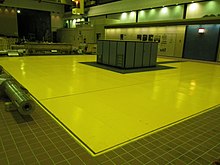Churchill Falls Generating Station
| Churchill Falls Generating Station | |
|---|---|
 |
|
|
Location of Churchill Falls Generating Station in Canada Newfoundland and Labrador
|
|
| Location |
Newfoundland and Labrador, Canada |
| Coordinates | 53°31′43.45″N 63°57′57.15″W / 53.5287361°N 63.9658750°WCoordinates: 53°31′43.45″N 63°57′57.15″W / 53.5287361°N 63.9658750°W |
| Construction began | 1967 |
| Opening date | 1974 |
| Construction cost | 946 million CAD |
| Owner(s) | CFLCo |
| Dam and spillways | |
| Type of dam | 88 rock-filled dikes |
| Impounds | Churchill River |
| Length | 64 km (40 mi) |
| Dam volume | 2,200,000 m3 (2,900,000 cu yd) |
| Reservoir | |
| Creates |
Smallwood Reservoir Ossokmanuan Reservoir |
| Total capacity | 32.64 km3 (1.153×1012 cu ft) |
| Catchment area | 71,750 km2 (27,700 sq mi) |
| Surface area | 6,988 km2 (2,698 sq mi) |
| Power station | |
| Operator(s) | CFLCo |
| Commission date | 1971-74 |
| Hydraulic head | 312.4 m (1,025 ft) |
| Turbines | 11 |
| Installed capacity | 5,428 MW |
| Annual generation | 35,000 GWh (130,000 TJ) |
|
Website www |
|
The Churchill Falls Generating Station is a hydroelectric power station located on the Churchill River in Newfoundland and Labrador. The underground power station can generate 5,428 MW, which makes it the second-largest in Canada, after the Robert-Bourassa generating station. The generating station was commissioned between 1971 and 1974. The facility is owned and operated by the Churchill Falls Labrador Corporation Limited (CFLCo), a joint venture between Nalcor Energy (65.8%) and Hydro-Québec (34.2%).
The Innu were early travellers to the site. To them, it was known as Patses-che-wan, "the narrow pass where the waters drop".
In 1915, the Quebec Streams Commission sent engineer Wilfred Thibaudeau survey the Labrador Plateau, then a part of Quebec. Thibodeau was impressed by the site and engineered a channel scheme which could be used to divert the water from the river before it arrived at the falls. The scheme would use the natural capacity of the basin, thereby eliminating the need for the construction of massive dams.
Newfoundland obtained jurisdiction over Labrador in a 1927 ruling of the Judicial Committee of the Privy Council. In 1947, Commander G.H. Desbarats, under the direction of the Newfoundland Government, completed a preliminary survey that confirmed Thibaudeau's findings. However, development did not proceed due to the inhospitable terrain, the severe climatic conditions, the geographic remoteness, the long distance transmission requirement and the lack of markets for such a large block of power.
In August, 1949, Joey Smallwood, Premier of Newfoundland, had the opportunity to see Churchill Falls for the first time and it became his obsession to develop the hydroelectric potential of the falls.
...
Wikipedia

